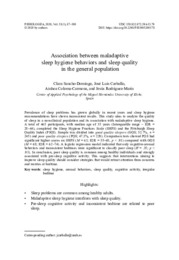Please use this identifier to cite or link to this item:
https://hdl.handle.net/11000/33991
Association between maladaptive sleep hygiene behaviors and sleep quality in the general population
Title:
Association between maladaptive sleep hygiene behaviors and sleep quality in the general population |
Authors:
Sancho-Domingo, Clara 
Carballo, José Luis 
Coloma-Carmona, Ainhoa 
Rodríguez-Marín, Jesús  |
Editor:
National Library of Serbia |
Department:
Departamentos de la UMH::Psicología de la Salud |
Issue Date:
2020 |
URI:
https://hdl.handle.net/11000/33991 |
Abstract:
Prevalence of sleep problems has grown globally in recent years and sleep hygiene
recommendations have shown inconsistent results. This study aims to analyze the quality
of sleep in a non-clinical population and its association with maladaptive sleep hygiene.
A total of 465 participants, with median age of 35 years (Interquartile range – IQR =
28–44), completed the Sleep Hygiene Practices Scale (SHPS) and the Pittsburgh Sleep
Quality Index (PSQI). Sample was divided into good quality sleepers (GQS; 52.7%, n =
245) and poor quality sleepers (PQS; 47.3%, n = 220). Comparison tests showed PQS had
significant higher scores on SHPS (M = 61; IQR = 55–68, p < .01) compared with GQS
(M = 68; IQR = 62–74). A logistic regression model indicated that only cognitive-arousal
behaviors and inconsistent bedtimes were significant to classify poor sleep (R2 = .35; p <
.01). In conclusion, poor sleep quality is common among healthy individuals and strongly
associated with pre-sleep cognitive activity. This suggests that interventions aiming to
improve sleep quality should consider strategies that would retract attention from concerns
and worries at bedtime.
|
Keywords/Subjects:
sleep hygiene
arousal behaviors
sleep quality
cognitive activity
irregular bedtime |
Knowledge area:
CDU: Filosofía y psicología: Psicología |
Type of document:
info:eu-repo/semantics/article |
Access rights:
info:eu-repo/semantics/openAccess
Attribution-NonCommercial-NoDerivatives 4.0 Internacional |
DOI:
https://doi.org/10.2298/PSI190520017S |
Published in:
Psihologija 2020 Volume 53, Issue 1, Pages: 87-100 |
Appears in Collections:
Artículos- Psicología de la Salud
|
 ???jsp.display-item.text9???
???jsp.display-item.text9???

.png)
